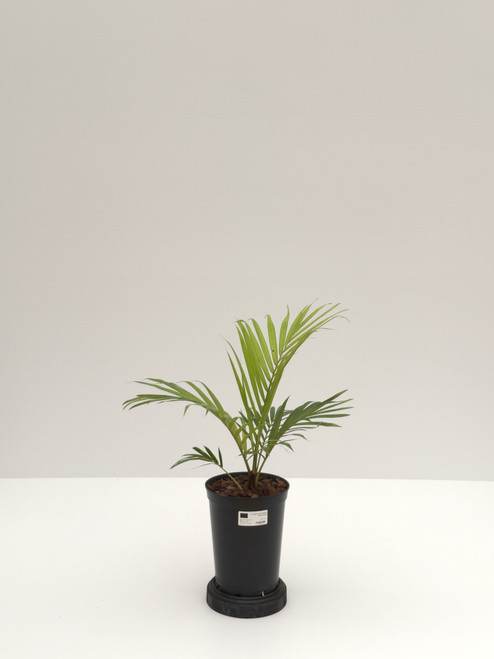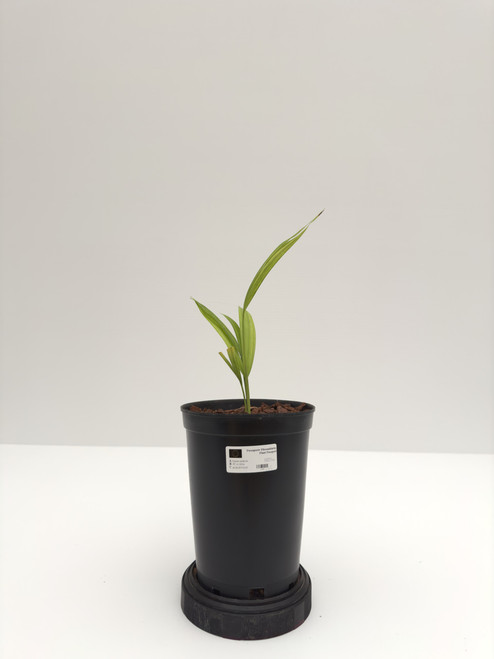Product Description
Habitat and Distribution
Madagascar. East coast between Vatomandry and Tolanaro. Moist or dry forest (remnants), also ?rejuvenating in savoka; slight or steep mid slopes; alt. 30-200 m.
Description
Solitary palm. TRUNK 6-25 m, cylindrical, 14-29 cm. in diam. (to 12 cm. in diam. near the crown), internodes 10-50 cm (near the crown to 5 cm), green, ringed, nodal scars white, 2-4 cm; wood very hard with red fibres. LEAVES tristichous, porrect to arching, 6-10 per crown; sheath 0.6-1.6 m long, a quarter to two-thirds open, whitish green to pale yellow-green to bright orange-yellow in recently exposed sheaths, with characteristic slighly sunken, white, waxy, large (4-12 x 2-3 mm) scales with scalloped edges, auricles about 1 cm; petiole absent or up to 12 cm long, with scales as the sheath, 5-10 x 3-7 cm. in diam., deeply canaliculate with sharp edges; rachis 3-3.5 m long, in mid-leaf 2.5-4 cm wide, proximally canaliculate, more distally keeled, pale brown, with scales as the sheath; pinnae slightly irregular or in groups of 3-7, but always in several planes, arching, 121-149 on each side of the rachis, the group interval 1.5-17 cm, basal pinnae 35-150 (-300) x 0.8-2.8 cm, median 100-135 x 2.2-4.6 cm, distal 18-50 x 0.5-2.5 cm, acuminate, glabrous, waxy, main vein 1 with thickened margins. INFLORESCENCE infrafoliar, branched to 3 orders, arching and with pendulous rachillae; peduncle 18-40 cm long, 6-12 x 3.5-7 cm. in diam., pale green, glabrous; prophyll erect, 45-65 x 11-17 cm, clearly 2-winged, borne at 5-8 cm above the base of the peduncle; peduncular bract inserted at 15-18 cm above the base of the peduncle, deciduous, 80-120 x 10-20 cm, beaked for 6-10 cm, closed in the distal 15 cm, coriaceous, with a waxy bloom; non-tubular peduncular 8-29 x 4-7 cm; rachis 70-106 cm long, pale pastel green with 14-23 branched and 14-20 unbranched first order branches; rachillae whitish to pale pastel green, 17-58 cm long, 3-5 mm. in diam. STAMINATE FLOWERS with sepals 1.3-1.6 x 1.2-1.5 mm, red-spotted; petals 2-2.2 x 1.4-1.5 mm; stamens 6, uniseriate, filaments 1.7-2 mm, anthers 1-1.3 x 0.6-0.7 mm, versatile; pistillode 1.5-1.7 x 0.4-0.7 mm. PISTILLATE FLOWERS with sepals 1.5-2 x 1.6-2.3 mm, petals 2.2-2.4 x 1.8-2.3 mm; staminodes 0.2-0.4 mm; gynoecium 2-3.5 x 2-4 mm. FRUIT globose or nearly so, 4-6 mm, with fibrous endocarp, the fibres slightly anastomosing. SEED globose, 3.5-4.5 mm, with sub-basal depression, rounded at the base, apiculate or rounded at the apex, with homogeneous endosperm (occasionally with undulate edges). (J. Dransfield and H. Beentje. 1995)/Palmweb. Editing by edric.
Collections from several large populations in the Manakara area show that the variation within populations may range from almost regular leaflets in almost one plane to grouped and fanned pinnae (Perrier describes the leaflets of about fibrosus as "non groupés mais non tous inserés sur un même plan"). The group interval of 11-17 cm in the type of D. mananjarensis is rather extreme, the norm being 1-6 cm; it is possible that the leaf parts in this type come from a leaf from a young plant. The protologue of D. mananjarensis states that the type is a robust palm with a short trunk 4-6 m high, and this is certainly the size of an young tree; all flowering or fruiting specimens we have observed had trunks over 6 m tall, and usually over 10 m.
NOTE: within the enlarged genus Dypsis, the epithet fibrosa/um has been used earlier for Dictyosperma fibrosum = Vonitra fibrosa = Dypsis fibrosa. (J. Dransfield and H. Beentje. 1995)/Palmweb.
Culture
Full sun/light shade, well drained. Cold Hardiness Zone: 10a
Comments and Curiosities
A large and beautiful tristichous palm, in the horticultural world known as 'mealy bug', because of the prominent scales on the leaf sheath, petiole and rachis. These scales are white and waxy, with scalloped edges, and are unique within the genus. The scientific name comes from the fivondronana or 'county' of Mananjary, where the type was collected. (J. Dransfield and H. Beentje. 1995)/Palmweb.
Conservation: Vulnerable. Though this species may be locally common, the total number HB has seen are only a few hundred. Over the whole distribution area the vegetation is being destroyed for agricultural land or by burning; the cutting for palm-heart targets this palm specifically. (J. Dransfield and H. Beentje. 1995)/Palmweb.
Uses: Good palm heart, and cut down for primarily, because the rachis produces a fibre at one time much used by the Betsimisaraka. (J. Dransfield and H. Beentje. 1995)/Palmweb.
D. mananjarensis is known in the trade as the Mealy Bug Palm, a reference to the prominent waxy, white scales borne on the leaf sheath, petiole and rachis. No other described Dypsis species possesses such a feature. As a native of both moist and dry habitats, it fits well into the climatic patterns of southern Florida. Like D. decaryi, D. mananjarensis carries its leaves in three ranks. Leaflets vary from population to population; some are regularly-spaced along the rachis, while others are arrayed in groups. In habitat, trunks reach 20 to 81 ft. in height and 5½ to 11½ in. in diameter. Its IUCN conservation status is Near Threatened, due in part to its being harvested for its tasty heart. Its population trend is unknown. (fairchildgarden.org)
California palm madman Mardy Darian's famous Mealy Bug Palm, is one of the grandest plants from the island of Madagascar, deriving its name from the white scales on the emerging leaf. It grows in forests at low elevation on the east coast of Madagascar. In cultivation it is a bit slow at first, but, with time, develops into a spectacular, large palm with a robust trunk to 30 cm (1 ft.) in diameter and 25 m (82 ft.) tall. It does best in the tropics but can adapt to many warm temperate climates. (RPS>com)







